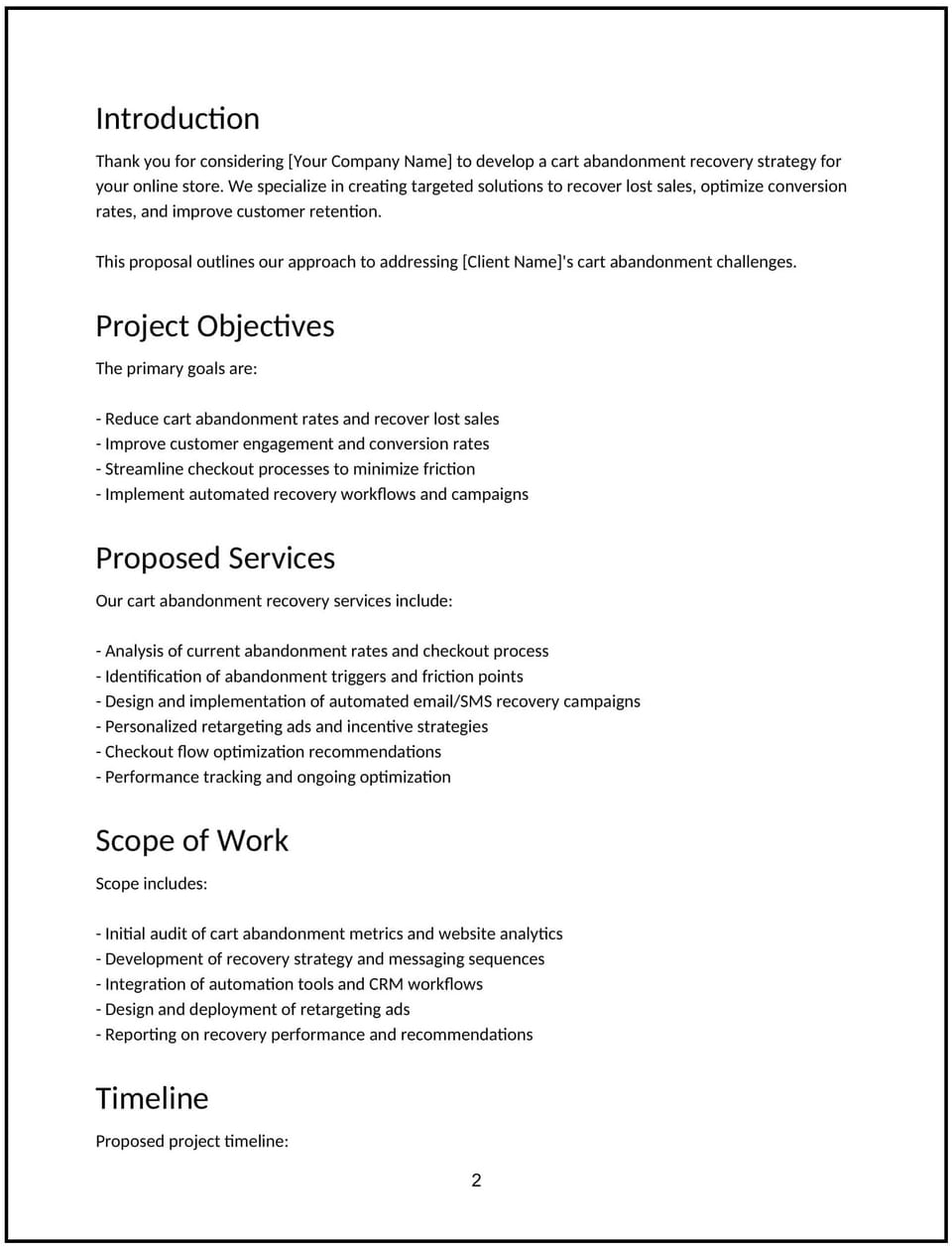Cart abandonment recovery strategy proposal: Free template

Customize this free cart abandonment recovery strategy proposal with Cobrief
Open this free cart abandonment recovery strategy proposal in Cobrief and start editing it instantly using AI. You can adjust the tone, structure, and content based on your service model, the store’s platform, and their target customer journey. You can also use AI to review your draft — spot gaps, tighten language, and improve clarity before sending.
Once you're done, send, download, or save the proposal in one click — no formatting or setup required.
This template is fully customizable and built for real-world use — ideal for pitching cart recovery solutions to e-commerce brands, DTC businesses, or online retailers with high bounce or checkout drop-off rates. Whether you’re creating proposals daily or occasionally, this version gives you a structured head start and removes the guesswork.
What is a cart abandonment recovery strategy proposal?
A cart abandonment recovery strategy proposal outlines how you'll help an e-commerce business recover lost sales from shoppers who leave during or after the checkout process. It typically includes segmentation, email/SMS automations, incentive structures, retargeting, and UX improvements.
This type of proposal is commonly used by email marketers, CRO experts, and e-commerce consultants working with stores looking to improve their revenue efficiency.
A strong proposal helps you:
- Identify where and why shoppers are dropping off.
- Show how your strategy will re-engage them and bring them back to purchase.
- Set clear deliverables like flows, copy, and platform setup.
- Frame your solution as a low-lift, high-ROI upgrade to existing operations.
If you offer retention marketing, performance strategy, or e-commerce automation services, this is the right kind of proposal to use.
Why use Cobrief to edit your proposal
Instead of copying a static template, you can use Cobrief to tailor and refine your proposal directly in your browser — with AI built in to help along the way.
- Edit the proposal directly in your browser: No setup or formatting required — just click and start customizing.
- Rewrite sections with AI: Highlight any sentence and choose from actions like shorten, expand, simplify, or change tone.
- Run a one-click AI review: Get instant suggestions to improve clarity, fix vague sections, or tighten your message.
- Apply AI suggestions instantly: Review and accept individual AI suggestions, or apply all improvements across the proposal in one click.
- Share or export instantly: Send your proposal through Cobrief or download a clean PDF or DOCX version when you’re done.
Cobrief helps you create a polished, persuasive proposal — without wasting time on formatting or second-guessing your copy.
When to use this proposal
This cart abandonment recovery proposal works well in scenarios like:
- When helping e-commerce stores increase revenue without spending more on traffic.
- When improving or replacing underperforming recovery emails or SMS flows.
- When preparing for high-traffic seasons (e.g., BFCM, holidays).
- When responding to a drop in checkout conversion or rise in bounce rate.
Use this proposal whenever you want to show a client how you’ll win back missed revenue quickly and effectively.
What to include in a cart abandonment recovery strategy proposal
Each section of the proposal is designed to help you explain your offer clearly and professionally. Here's how to use them:
- Executive summary: Highlight the revenue being left on the table and how your strategy will recover a percentage of that through automated, timely, and targeted follow-ups.
- Scope of work: Break down your approach — funnel analysis, segmentation, copywriting, flow creation (email/SMS), A/B testing, platform setup (e.g., Klaviyo, Postscript), and performance tracking setup.
- Timeline: Include a phase-based plan — initial audit, asset creation, launch, and optimization. Most cart recovery setups take 2–4 weeks to complete.
- Pricing: Offer flat-fee setup or performance-based pricing. You can also include a retainer for ongoing testing and optimization.
- Terms and conditions: Set expectations on access requirements, platform limitations, timelines, ownership of creative, and reporting deliverables.
- Next steps: Include a clear CTA — e.g., “Approve this proposal to schedule your funnel audit” or “Provide platform access to begin strategy setup.”
How to write an effective cart abandonment recovery strategy proposal
Use these best practices to highlight ROI, speed, and clarity:
- Make the client the focus: Emphasize revenue recovery and simplicity — not just strategy or tools.
- Personalize where it matters: Mention platform (e.g., Shopify, WooCommerce), customer type, or product category.
- Show results, not just ideas: Reference past wins (e.g., “12% recovered revenue in 30 days”) to build confidence.
- Be clear and confident: Explain technical parts in plain language. Focus on value, not just setup steps.
- Keep it skimmable: Use bullets and short paragraphs for busy founders or marketers.
- End with momentum: Give the client an easy way to start, even if it’s just a discovery call.
Frequently asked questions (FAQs)
What platforms do you use for cart recovery?
Most commonly Klaviyo, Omnisend, Postscript, and Shopify Email — but we’ll recommend based on your current stack and customer base.
How many emails or messages should be in the sequence?
Most flows include 2–4 touchpoints over 24–72 hours. We'll test timing and content to match your audience’s buying behavior.
Can I reuse this proposal for different types of stores?
Yes — just tailor the copy and platform details based on the store’s product type, brand voice, and price point.
Should I offer discounts in the recovery flow?
Not always. We often test with and without incentives. Sometimes urgency, social proof, or limited stock messaging performs better.
Do I need to integrate this with my existing email marketing?
Ideally yes — we’ll ensure the flows are connected to your email platform and don’t overlap or conflict with existing campaigns.
This article contains general legal information and does not contain legal advice. Cobrief is not a law firm or a substitute for an attorney or law firm. The law is complex and changes often. For legal advice, please ask a lawyer.